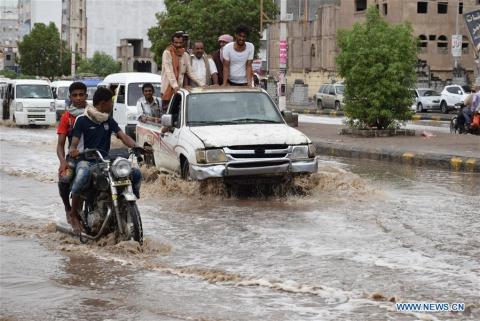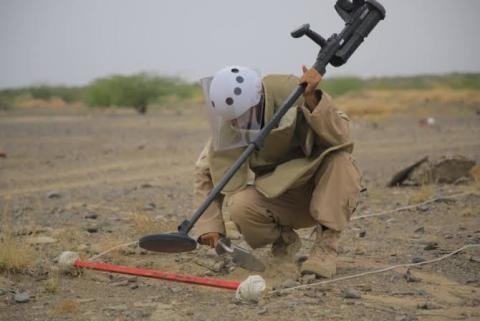Lack of international support fuels crisis in Yemen


The Republic of Yemen was founded on May 22, 1990 with the unification of two countries – the Yemen Arab Republic (north Yemen) and the People's Democratic Republic of Yemen (south Yemen).
The current population of Yemen is around 28 million people, of which 65 percent is Sunni and 35 percent is Shiite. The vast majority of Sunnis live in the south and southeastern parts of the country, while the northern part is dominated by the Shiite inhabitants (Zaidis).
Since 2011, the Republic of Yemen has been in a state of political crisis. This crisis began when a mass of people took to the streets to protest against poverty, unemployment, corruption, and the resignation of President Ali Abdullah Saleh. In face of the protests, President Saleh stepped down and Abdrabbuh Mansur Hadi was formally elected president on Feb. 21, 2012. In between this transitiona
l process, the central government was absent. Using this opportunity, the Houthis rebels of the Ansar-Allah militia and the al-Islah forces, as well as al-Qaida, got involved in a violent armed conflict.
In September 2014, the Houthis repaired their relationship with the former President Saleh and took control of the capital and much of the north. Since 2015, the Saudi Arabia and United Arab Emirates (UAE)-led coalition intervened in Yemen leading to the worst humanitarian crisis in the world. In December 2017, Saleh was shot dead in Sanaa resulted in a new civil war and a Saudi Arabian-led military intervention aimed at restoring Hadi's government. As of now, more than 60,000 civilians and combatants have been killed in armed violence in Yemen since January 2016. In this conflict, Malaysia's military involved under the Najib Razak (the former prime minister of Malaysia) administration, which was condemned by current Prime Minister Tun Dr. Mahathir bin Mohamad, the then opposition leader.
'Stand with Yemen'
After the conflict in Yemen entered its fourth year on Saturday Feb. 23, 2019, the International Institute of Islamic Civilization & Malay World (ISTAC) of the International Islamic University Malaysia (IIUM) organized a symposium, "Stand with Yemen," in Taman Duta, Kuala Lumpur. In this symposium, Prime Minister Mahathir Mohamad clearly stated, "We will not take sides in big power rivalries, and neither will we rely on military alliances or strategic partnerships."
Through this he reaffirmed the country's non-interference policy. Malaysia decided to maintain distancing itself from the previous government's support for the Saudi-led military campaign. Instead Mahathir underlined that Muslim nations need to turn away from war and start working to uplift the socioeconomic well-being of all.
The symposium highlighted that the main crisis in Yemen is the product of three types of wars. Firstly, a war on terrorism led by the United States of America. Secondly, a proxy war between Saudi Arabia and Iran. The former wants to restore the regime of President Hadi while the latter supports the Houthi movement to turn against President Hadi. The last and the most important one is the civil war between north Yemen and south Yemen as result of the failure of the 1990 unity between the two countries. In this symposium, a number of issues were discussed from different points of view. However, we feel that the economic issue has not received much attention. In this short piece, we will focus on likely economic consequences of the civil war between north Yemen and south Yemen in the following lines.
Civil War
South Yemen covers around 70 percent of the area of the Republic of Yemen with a population around 5 million, while north Yemen stands at 30 percent with a population of over 20 million. The civil war escalated in 2015 when the Houthis took control over the country because the political and military elites in northern Yemen felt that the south had intentions to return back to their country, which was independent before the unity of 1990. In 1994, Yemen experienced a civil war between the northern and southern parts and thus, the unity between them collapsed.
In 2015, the Houthis took the control of north Yemen without resistance and then they moved toward the south with strong support by the official army of Yemen which is controlled by the south since the war in 1994. This situation created strong resistance when the Arab Alliance led by Saudi Arabia gave military aid to the south. Thus, the south took back control of their country. This new scenario generated enormous hatred and enmity between northern and southern Yemen with regards to the control of economic resources when the majority of resources such as oil and gas was centralized in the south. Thus, the war turned into an economic war between the Houthis and the official government. President Hadi transferred the central bank from Sanaa in the north to Aden in the south.
AFP.

Yemeni officials on Monday condemned arrests and prosecutions by the Iran-backed Houthi militia directed against media, journalists and celebrities…

Yemen's warring parties are gearing up for new waves of conflict in 2023 amid a lack of decisive steps towards sustainable peace, adding to the suf…

The UAE will help to recruit doctors and deliver crucial supplies for hospitals in Yemen under a major healthcare drive. The Khalifa bin…